

ORDER PASSERIFORMES
The name “Passeriforme” comes from Passer domesticus, the scientific name of our famous House Sparrow, known throughout the world and common bird around our houses.
Photographers:
Alfredo Colón
Puerto Rico Wildlife
Aurélien Audevard
OUESSANT DIGISCOPING
Bob Moul
Nature Photography
Jean Michel Peers
JMPN PHOTOGRAPHIE
Tom Grey
Tom Grey's Bird Pictures
Text and other pictures by Nicole Bouglouan
Sources:
Imago Mundi – Encyclopédie gratuite
Wikipedia (Wikipedia, the Free Encyclopedia)
This large order groups together 93 families and more than 6000 birds’ species.
Passeriformes may be small, medium-sized or large birds. One of the smallest, the Pygmy Tit (Psaltria exilis) from Indonesia is about 4 cm long, whereas one of the largest, the Common Raven (Corvus corax) may reach almost 70 cm.
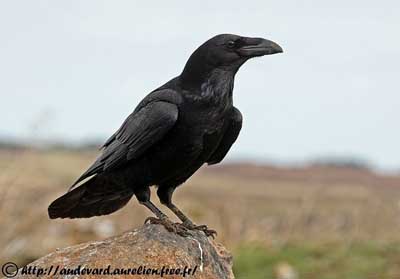
Except the Corvidae family's members, all these birds utter beautiful and various songs, with melodious phrases and liquid notes. It is very pleasant to hear them in the early morning when the spring is coming.
Passeriformes often are insectivorous during the nesting period, but usually, they consume both insects and seeds, and also fruits and berries in autumn.
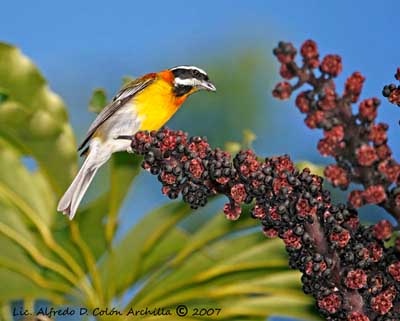
They perform fast flight with steady wing beats. On the ground, they hop or walk rapidly.
Numerous families have rather dull plumage, often grey, brown or blackish on the upperparts. The underparts may be paler with darker spots, streaks or specks.
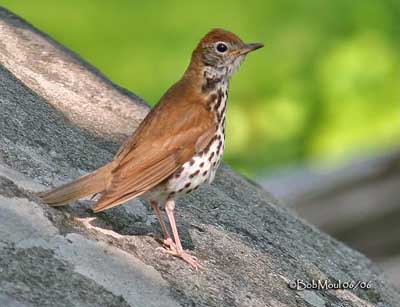
However, several Passeriformes show bright-coloured plumages.
Male and female often differ. The male has brighter colours than the female which incubates the eggs, and needs to be almost invisible at nest. The young are very similar to the female until the first moult.

During the breeding season, the Passeriformes become aggressive and territorial, defending strongly their area and the nest-site.
They perform courtship displays by singing, flying, the male strutting close to the female, playing with the brighter colours of his feathers in order to expose the best parts of the plumage.
They live in pairs during the breeding season, but they are seen in mixed flocks outside this period.

Some species migrate after the nesting season, flying southwards for wintering. Others perform some altitudinal dispersions, or move according to the food resources.
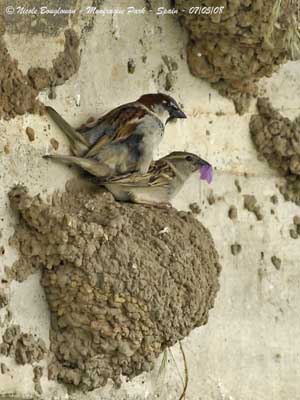
Passeriformes usually breeds in spring, except some species living in cold or warm countries where the reproduction may occur at different periods of the year, or even all year round.
The birds form a pair and leave the winter flocks. The male is always busy, defending the territory, chasing rivals and intruders, courting the female and protecting the nest.
He sings very nicely and cares the female, displaying in front of her before the copulation.
The nice nest may be situated in tree, bush, hole in tree or crevice in the rock, on the ground among the grass, in reeds, tussocks…
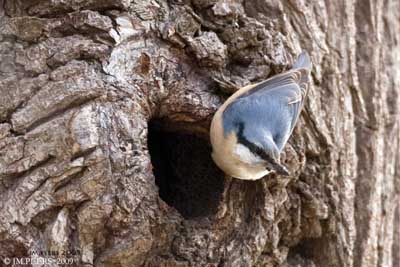
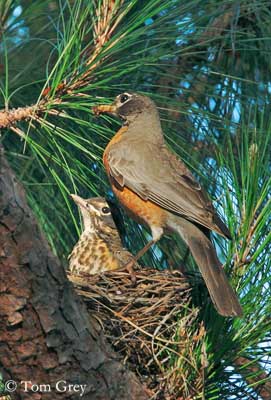
The exterior is often made with materials found in the surroundings, in order to make the nest well camouflaged. The interior is lined with soft materials such as fine grasses, feathers, hair, wool or plant down.
Usually, the female incubates the eggs while she is fed by the male, but both sexes feed and care the young.
The Passeriformes may produce between one and four broods per year.
As all the birds, the Passeriformes are threatened by predators such as birds of prey, mammals, snakes and sometimes humans.
They are vulnerable to habitat loss due to changes, destruction, deforestation and human developments.
Numerous species are living close to humans, and may damage crops and orchards. But they also are useful because they consume thousands of insects and eat the seeds of the weeds in the cultivated areas.
Passeriformes frequent more often woodlands and forests than plains and deserts. They usually prefer open areas with vegetation, trees, bushes, scrubs, at forest edges.
They are able to live in cold mountains or tropical areas, in cities, towns and villages or in plains and deserts. Passeriformes are common almost in the whole world.
